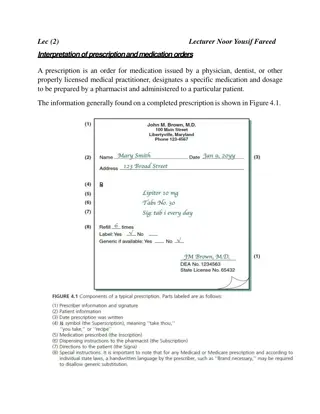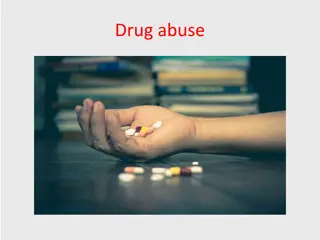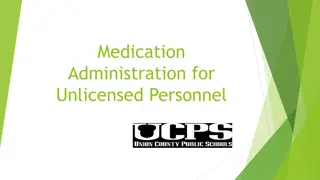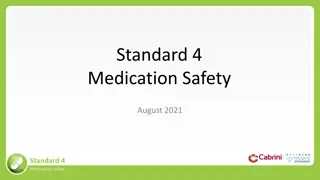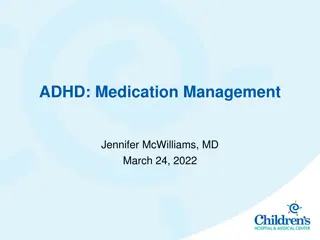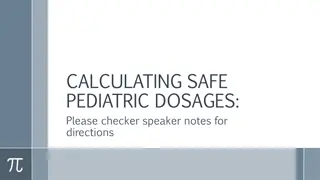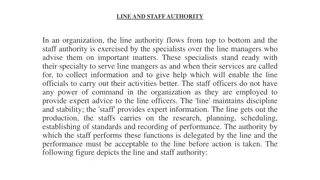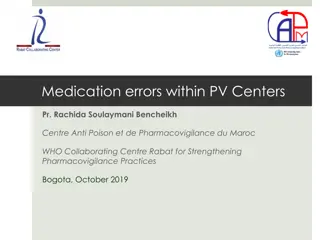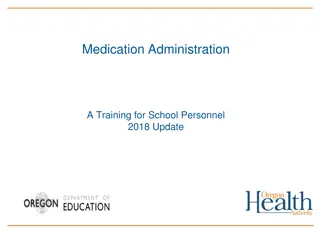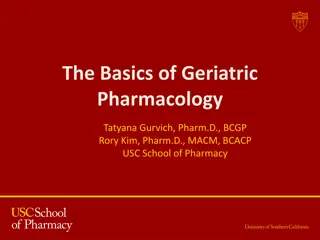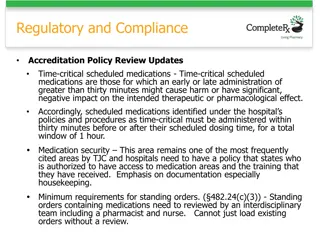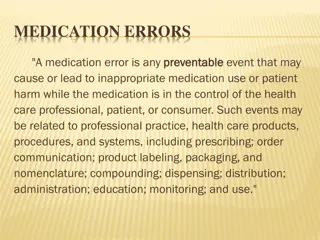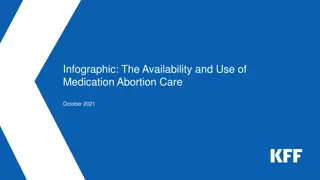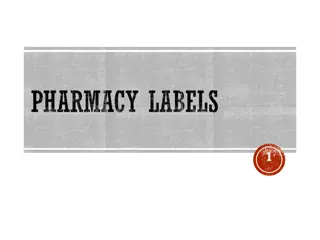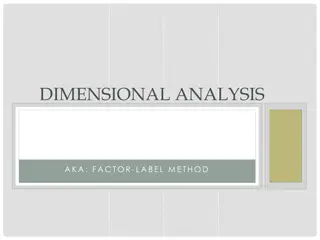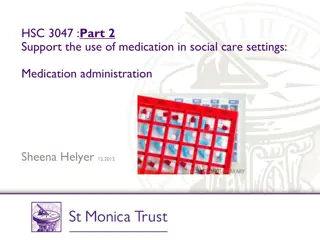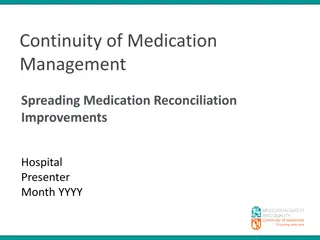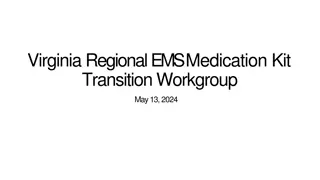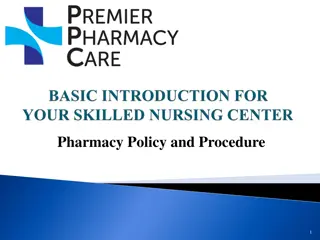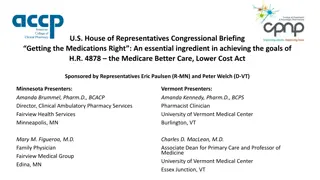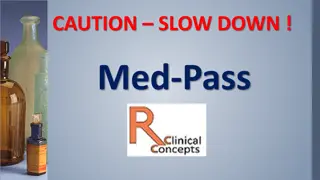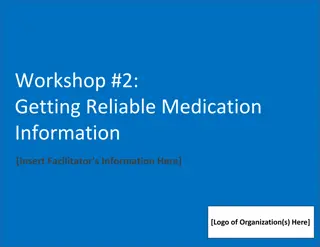Medication Administration Process and Staff Responsibilities Overview
Detailed information on medication administration process, responsibilities of staff members, and general guidelines for ensuring safe and effective medication management. The process involves prescribing medication, filling prescriptions, monitoring the individual, assistance in administration, and documentation. Staff responsibilities include observation, noting changes, informing physicians, pharmacy visits, and proper documentation. General responsibilities focus on adherence to laws and policies, normalization, independence, safety, and sanitation procedures. Boundaries, verbal orders, and storage requirements are also highlighted in this comprehensive guide.
Download Presentation

Please find below an Image/Link to download the presentation.
The content on the website is provided AS IS for your information and personal use only. It may not be sold, licensed, or shared on other websites without obtaining consent from the author. Download presentation by click this link. If you encounter any issues during the download, it is possible that the publisher has removed the file from their server.
E N D
Presentation Transcript
Medication Module .06 February 2022 Melody Baker, Staff trainer Kalix Updated September 2023
MEDICATION: A SUBSTANCE OR MIXTURE (OTHER THAN FOOD) THAT IS USED TO: PREVENT DISEASE AID IN DIAGNOSIS TREAT A DISEASE OR REDUCE SYMPTOMS MAINTAIN/RESTORE NORMAL FUNCTION
MEDICATION ADMINISTRATION PROCESS Observation Prescription Administration Documentation
PEOPLE IN MEDICATION ADMINISTRATION PROCESS Physician prescribes medication Pharmacistfills prescription and dispenses medication (A pharmacist is the only one who can dispense medication.) Nurse monitors the person Staff assist in administration
MEDICATION CYCLE physician nurse staff Individual staff pharmacist
STAFF RESPONSIBILITIES observation note __________ CHANGES inform physician of changes take prescription to pharmacy administration the medication as ordered then document
4 GENERAL RESPONSIBILITIES OF STAFF Know and adhere to laws and agency policy 1. Apply normalization and teach independence 2. Know and observe effects 3. Ensure safety and sanitation procedures 4.
1. KNOW AND ADHERE TO LAWS AND AGENCY POLICY
BOUNDARIES KNOW YOUR ______________ PERFORM ONLY SKILLS TRAINED IN AT THIS AGENCY FOLLOW AGENCY POLICIES WORK UNDER AGENCY ___________ LICENSE KNOW ____________ REQUIREMENTS STORAGE NURSE S NURSE STAFF RESPONSIBILITIES RESPONSIBILITIES
VERBAL ORDERS IN ND ONLY A LICENSED MEDICAL PERSON (AGENCY NURSE) CAN TAKE VERBAL ORDERS OVER THE _______ PHONE IF PHYSICAN CALLS, STAFF REFER TO THE AGENCY __________ NURSE
CONTROLLED SUBSTANCE CONTROLLED MEDICATION ARE THOSE WHICH ARE LIKELY TO BE ___________ ADDICTIVE WHAT DOES THIS MEAN FOR STAFF? A WARNING LABEL ________ REFILLS USUALLY ONLY ONE MONTH SUPPLY SCHEDULE II - _________________ DOCUMENT NUMBER LIMITED DOUBLE LOCK
2. APPLY NORMALIZATION AND TEACH INDEPENDENCE
APPLYING NORMALIZATION & TEACHING TOOLS use least restrictive methods let ________ do as much for themselves as possible their interdisciplinary _________ decides what should be taught people TEAM
Ways Active Support can be used to engage people in the med process: use the phone to make appointments arrange _____________ to appts pick up prescription Bring a glass of water to the med room Know the __________ of medication knowing when to take their meds TRANSPORTATION EFFECTS
3. KNOW AND OBSERVE EFFECTS
WE NEED TO KNOW ACTS how the person looks and _________ what medications they are on and ___________ effects & response time DESIRED what potential _________ effects SIDE
Use all your senses for clues to side effects: visual auditory smell touch
THREE PRIMARY EFFECTS DESIRED 1. ___________ EFFCTS WHAT WE WANT THE MEDICATION TO DO i.e. reduce temperature When the medication is working correctly, the desired effect is produced.
THREE PRIMARY EFFECTS NO APPARENT 2. _______________ EFFECTS NO SIGNS OF AN EFFECT TYLENOL FOR FEVER AND FEVER STILL THE SAME
3. SIDE EFFECTS (EFFECTS OTHER THAN DESIRED) FATAL MILD SEVERE (POTENTIALLY ______________) EXPECTED or UNEXPECTED
OBSERVE FOR _______________ REACTION. REACTIONS CAN OCCUR ANYTIME BUT MOST OFTEN AFTER THE _____________ FEW DOSES SKIN RASH,DIARRHEA, ITCHING, WATER DISCHARGE FROM NOSE, IRRITABILITY, TIREDNESS, HIVES ALLERGIC FIRST
A severe allergic reaction is ANAPHYLACTIC SHOCK It is a medical ___________________ EMERGENCY
MEDICATION INTERACTIONS POTENTIATION AN ____________ IN THE EFFECT BEER + MUSCLE RELAXANT INCREASE ANTAGONISM DECREASE A _______________ IN THE EFFECTS TETRACYCLINE with MILK UNIQUE EFFECT A NEW & DIFFERENT EFFECT
FOLLOW AGENCY POLICY FOLLOW AGENCY POLICY WHEN NO APPARENT EFFECT AFTER RESPONSE TIME STAFF RESPONSIBILITY IF SUSPECT MEDICATION INTERACTION IS TO: _____________ TO NURSE/SUPERVISOR _____________ SYMPTOMS DOCUMENT REPORT
Medication response can be influenced by: Illness or disease Body weight Age Gender Medication response
CHARACTERISTICS TO KNOW ABOUT PEOPLE:
5) PHYSICAL CONDITION OF SKIN 1) GENERAL APPEARANCE 2)BODY ________________ POSTURE 6) PHYSICAL CONDITION OF _______ AND SCALP HAIR 3) GENERAL STATE OF HEALTH 7) PHYSICAL CONDITION OF SENSES 4) PHYSICAL ACTIVITY LEVEL 8) __________________________ SPEECH
Mouth 9)____________, GUMS AND TEETH 13) BOWEL AND BLADDER 14) APPETITE AND EATING HABITS 10) FACIAL EXPRESSIONS 15) GENERAL ____________ STATE EMOTIONAL 11) VITAL SIGNS 16) STATE OF AWARENESS 12) _____________ WEIGHT
4. ENSURE SAFETY AND SANITATION PROCEDURES
Wash hands before and after administering any medication
Safety Never recap a needle Use gloves when taking blood sugar Protective barriers- Gloves protective eye wear protective clothing
6 RIGHTS OF MEDICATION ADMINISTRATION RIGHT PERSON RIGHTROUTE RIGHT MEDICATION RIGHTDOSE RIGHT DOCUMENTATION RIGHTTIME
RIGHT PERSON IDENTIFY THE PERSON __________ GIVING MEDICATION BEFORE KNOW THE PERSON ONE ONLY GIVE MEDICATIONS TO _______ PERSON AT A TIME
RIGHT MEDICATION MATCH __________ AND __________ LABEL MAR 2 WAY CHECK REPORT FOLLOW AGENCY POLICY TO ________ DISCREPANCIES (DIFFERENCES)
WHAT THESE MEDICATIONS ARE FOR: SEIZURES ANTICONVULSANT -CONTROL ______________ ANTIBIOTICS - TREAT INFECTIONS ANTIDEPRESSANTS RELIEVE DEPRESSION INSULIN - TREATS ___________________ STEROIDS REDUCE INFLAMATION ANTACIDS - RELIEVE ______________________ LAXATIVE - RELIEVE _________________ CONSTIPATION DIABETES UPSET STOMACH
RIGHT DOSE Therapeutic ______________ RANGE: A RANGE OF DOSES THAT CAN PRODUCE DESIRED EFFECTS WITH MINIMUM SIDE EFFECTS
RIGHT DOSE MAKE SURE TO ____________________ NUMBER OF TABLETS or CAPSULES READ AND COUNT
Right Time TAKING THE MEDS AT THE SAME TIME EVERY DAY KEEPS CONSISTENT LEVELS ONE HOUR BEFORE TO ONE HOUR AFTER (FOLLOW AGENCY POLICY) CONTACT NURSE IF OUTSIDE OF MED TIME
Right Time MEDS TAKEN ON AN_______________ STOMACH ENTER SYSTEM QUICKER (Medications required to be taken before eating means the medication should be taken on an empty stomach) EMPTY MEDS TAKEN ON A_____________ STOMACH AVOIDS IRRITATION FULL
TIME ABBREVIATIONS PRN as needed
RIGHT ROUTE BODY THE PART OF THE ______________ TO WHICH THE MEDICATION IS ADMINISTERED INTERNAL TAKEN BY MOUTH AND __________________ EXTERNAL APPLIED TO THE _____________ OF THE BODY CREAMS EYE DROPS EAR DROPS (otic ) INTERNAL AND EXTERNAL STORED _______________ SWALLOWED OUTSIDE SEPARATELY
ABBREVIATIONS p.o. ____ by mouth Opth- pertaining to the eye ________ pertaining to the ear I.V. intravenous injection _______ sublingual(under the tongue) otic SL
Right documentation Documentation is done immediately after the medication is given. Only the person who gives the medication can initial the MAR
Procedure for Medication administration
MEDICATION ADMINISTRATION CORRECT ________ TIME WASH HANDS ________ MEDICATION STORAGE UNLOCK CHECK _______ & ________ (2 times) MAR LABEL TEACH THROUGHOUT PROCESS
MEDICATION ADMINISTRATION PROCEDURES: 1. REMOVE RIGHT DOSE SWALLOW 2. OBSERVE THE PERSON ______________ 3. REPLACE MEDICATION IN LOCKED STORAGE 4. _______ THE MEDICATION CHART 5. _________ FOR DESIRED/SIDE EFFECTS OBSERVE
LIQUID MEDICATION ADMINISTRATION SHAKE 1. __________ BEFORE POURING 2. POUR AWAY FROM LABEL SIDE 3. POUR AT ________ LEVEL 4. POUR JUST BEFORE GIVING 5. DO NOT _______ MEDICATIONS 6. OBSERVE SWALLOWING EYE MIX
MEDICATION ADMINISTRATION RECORD MAR Medication can only be given when ordered by a physician. _____________ orders are used for medications for headaches or a cold or something that the person doesn t need every day. That could be an over-the- counter (OTC) medication prescribed for specific reasons. STANDING
MEDICATION ADMINISTRATION RECORD MAR MEDICATIONS GIVEN ARE RECORDED ON THE MAR DOCUMENT: ________ GIVEN _________ STAFF INITIALS TIME DOSE

 undefined
undefined
 undefined
undefined undefined
undefined
